

 |
Search the Site with

|
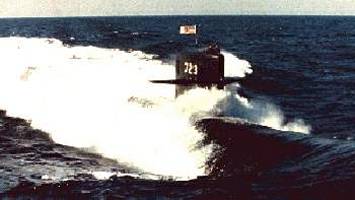 | 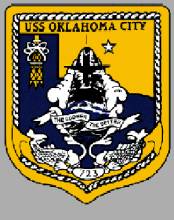 | 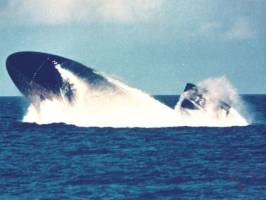 |
USS OKLAHOMA CITY is one of the LOS ANGELES class attack submarines and the second ship in the Navy to bear the name.
| General Characteristics: | Awarded: August 13, 1981 |
| Keel Laid: January 4, 1984 | |
| Launched: November 2, 1985 | |
| Commissioned: July 9, 1988 | |
| Builder: Newport News Shipbuilding Co., Newport News, Va. | |
| Propulsion system: one nuclear reactor | |
| Propellers: one | |
| Length: 360 feet (109.73 meters) | |
| Beam: 33 feet (10 meters) | |
| Draft: 32,15 feet (9.8 meters) | |
| Displacement: Surfaced: approx. 6,255 tons | |
| Submerged: approx. 7,102 tons | |
| Speed: Surfaced: approx. 15 knots | |
| Submerged: approx. 32 knots | |
| Armament: | |
| Cost: approx. $900 million | |
| Homeport: Guam | |
| Crew: 12 Officers, 115 Enlisted |
Crew List:
This section contains the names of sailors who served aboard USS OKLAHOMA CITY. It is no official listing but contains the names of sailors who submitted their information.
Commanding Officers of USS OKLAHOMA CITY:
| Period | Name |
|---|---|
| September 1985 - March 1987 | Commander Joseph J. Krol, USN |
| March 1987 - February 1991 | Commander Kevin J. Reardon, USN |
| February 1989 - July 1991 | Commander James C. Holloway, USN |
| July 1991 - March 19, 1994 | Commander Phillip M. Polefrone, USN |
| March 19, 1994 - August 2, 1996 | Commander Richard L. Snead, USN |
| August 2, 1996 - November 16, 1998 | Commander John G. Cooke V, USN |
| November 16, 1998 - | Commander James G. Foggo III, USN |
History of USS OKLAHOMA CITY:
The nuclear powered attack submarine USS OKLAHOMA CITY was commissioned at Norfolk Naval Base on July 9, 1988.
Oklahoma City deployed to the Mediterranean in March 1990 with the EISENHOWER Battlegroup and participated in Operation Desert Shield, received the Sixth Fleet "Hook'em" award for anti-submarine warfare excellence, and was awarded the Meritorious Unit Citation.
Oklahoma City won the 1990 and 1991 Battle Efficiency "E" from Commander, Submarine Squadron Eight for overall excellence in submarine operations. The ship also won the 1990 Engineering "E" for engineering excellence.
Oklahoma City deployed to the Mediterranean a second time in September 1991, again with the USS EISENHOWER Battlegroup, returning home in March 1992, then spent a year backfitting the Navy's most advanced sonar and fire control system, the BQQ-5E and CCS Mk2. From March 1993 through February 1995, Oklahoma City tested this state-of -the-art combat system, firing four Tomahawk and two Harpoon cruise missiles and over seventy torpedoes. The two year testing program was an unprecedented success - on-time and on-budget - a $2.5 billion (total) acquisition program to upgrade all non-improved Los Angeles class SSN combat systems tested and proofed without a glitch.
Oklahoma City then immediately worked-up and deployed to the Mediterranean for a third time, this time traveling with the USS AMERICA Battlegroup to the Arabian Gulf, and, fresh out of testing, won a third Battle Efficiency "E" from Commander, Submarine Squadron Eight. The ship also won the 1995 Supply "E" for logistics readiness and the 1994 Engineering "E" and won honorable mention in the 1996 Edward F. Ney food service competition.
Accidents aboard USS OKLAHOMA CITY:
| Date | Where | Events |
|---|---|---|
| November 13, 2002 | Mediterranean Sea east of the Strait of Gibraltar | USS OKLAHOMA CITY came into brief contact with another vessel while transiting the western Mediterranean Sea east of the Strait of Gibraltar. The accident occurred in international waters at approximately 1:30 p.m. (GMT). At the time of the incident, the submarine was proceeding to periscope depth. Preliminary reports indicated the OKLAHOMA CITY's sail made brief contact with another vessel's hull. The submarine surfaced and located a merchant vessel in close proximity. OKLAHOMA CITY attempted to make radio contact with the other vessel. However, the other vessel did not respond and did not appear to need assistance, and departed the area. OKLAHOMA CITY continued to search the area for other vessels in the vicinity. OKLAHOMA CITY returned to port for further inspection of damage and repairs. There were no injuries aboard OKLAHOMA CITY, and the damage appeared to be limited to the submarine's periscope and sail area. Cmdr. Richard Voter, commanding officer of USS OKLAHOMA CITY, was relieved of command Nov. 30 in La Maddalena, Sardinia. Voter, one other officer and two enlisted crew members were also disciplined in a non-judicial punishment proceeding Dec. 2. Charged with dereliction of duty, they each received punishment ranging from punitive letters of reprimand to reduction in rank. The officers were relieved of their duties and ordered to return to their prent squadron, Submarine Squadron 8, in Norfolk, Va. The enlisted crew members remained aboard the submarine. |
About the Ship’s Name, about Oklahoma City:
Oklahoma City was born on the afternoon of April 22, 1889, when the central portion of what is now Oklahoma was opened to settlement by presidential proclamation. Thousands crossed the borders of the "unassigned district" at the sound of gunfire at high noon. By the time the dust had settled on that historic day, many of these people had staked their claim at "Oklahoma Station," an area which was destined to become a leading city in 20th century America: Oklahoma City. The term "Sooner," a nickname for all Oklahomans, was also derived that day. As a term describing those "enterprising" individuals who crossed the border early (sooner than "legally" allowed) and were waiting on their compatriots with claims already staked, the Sooner designation is now a proud reminder of an unusual heritage.
Jumping from zero to 10,000 people in the space of a single afternoon is a growth feat hard to duplicate, and the city's growth rate has been orderly and steady over the last nine decades. Oklahoma City is one of the nation's largest cities in terms of land area, covering a total of 621 square miles.
The city developed as a distribution point for crops and cattle with extensive growth after being named state capital in 1910, three years after Oklahoma attained statehood. Now a major transportation center, it is the chief market processing point for the state's vast livestock industry, and a shipping point for cotton, wheat and cattle.
On December 4, 1928 oil was discovered beneath a section of the already growing city, leading to development of what was then the largest oil stake ever made. Today, petroleum remains a major industry in Oklahoma City with about 1,400 wells producing oil within the city limits, including some on the state capital grounds. The economy is, however, highly diversified with manufacturing of petroleum products, executive aircraft, oil-field machinery, electronic equipment, computers, and fabricated steel, merging with a rich agricultural and livestock industry.
The word Oklahoma is derived from two Choctaw Indian words: okla, "people" and humma, "red," which is especially fitting considering the deep Indian heritage of the state, formerly known as the Indian Territories. Additionally, the area was a major player in the development of the "wild west" and is the home of The National Cowboy Hall of Fame and Western Heritage Center.
Oklahoma City is a blend of old and new. Cowboys and Indians re-enact old customs in a modern metropolitan atmosphere that has developed flourishing medical research centers; major aeronautical, chemical, and electronic industries; extensive educational facilities, and renown cultural and entertainment activities. It is a city with a rich, rowdy history: modern, growing and on the move. It is a fitting namesake for a fast, powerful ship.
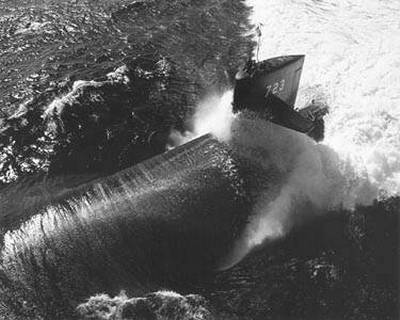
USS OKLAHOMA CITY Image Gallery:
The photos below were taken by Michael Jenning and show the Guam-based OKLAHOMA CITY undergoing a maintenance availability at Submarine Base Point Loma, Calif., on April 18, 2016.
 | 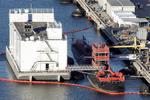 |
The photo below was taken by John Rebus (Michael) and shows the OKLAHOMA CITY dry docked in ARCO (ARDM 5) and undergoing repairs to her Emergency Diesel Generator (EDG) at Naval Base Point Loma, Calif., on June 2, 2016.
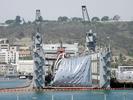 |
The photos below were taken by Michael Jenning and show the Guam-based OKLAHOMA CITY undergoing a maintenance availability at Submarine Base Point Loma, Calif., on October 6, 2016.
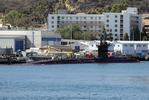 | 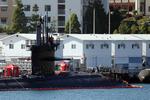 | 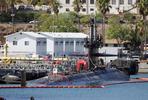 | 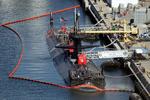 |
 Back to Submarines list.
Back to Submarines list.  Back to ships list.
Back to ships list.  Back to selection page.
Back to selection page.  Back to 1st page.
Back to 1st page.